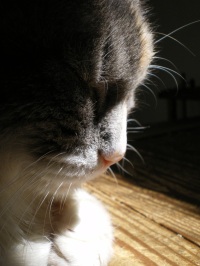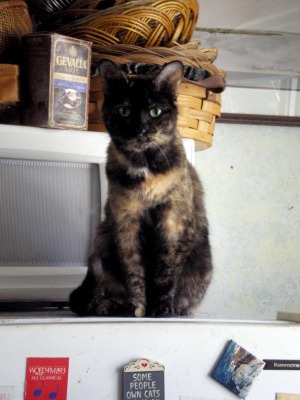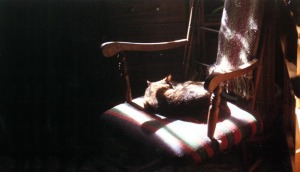Beyond Food and Water, Loving Care for Your Senior Cat, part 2

I’m proud to say that part two of this series won a Muse Medallion in the Cat Writers’ Association’s 2007 Communications Contest and the Hartz Mountain Everyday Chewable Vitamin Award for the best article on senior cat care in the same contest. That’s when I joined the Cat Writers’ Association and it’s been one of the best associations I’ve made in my career for both writing and learning.
Right now, your kitty is still pretty much at the top of his scratching post. He’s got the benefit of a good diet, lots of exercise with all his toys, and the knowledge that his little world really does revolve around him.
Many cats will go on like this well into their teens, still spry and playful with a good appetite and a good attitude, perhaps just sleeping a little more and losing a little muscle mass even with regular exercise. But just like humans, other cats will begin to deteriorate at a younger age, or will develop chronic or terminal illnesses. And because many of us have rescued our companions from a life on the streets, many will bear the marks of that early deprivation, well enough when young, but with increasing difficulty as they age.
Optimizing the Environment
Somehow, the favorite chair is a little higher than it was last year, it’s hard to lean down to the food bowl, those steps to the litter box in the basement are pretty scary and she’ll never get up on the bed without assistance again, it’s just too tall. Just as cats will adapt to or hide physical illnesses, so will they adapt to these growing daily challenges of aging. You’ll think perhaps your kitty doesn’t like that food, or wonder that suddenly he has developed terrible litter box habits and doesn’t want to sleep with you any more.
As you would if you thought your cat was ill, observe the changes to his habits and do your best to determine the cause. Does he sit on the floor and look longingly up on the chair or the bed? Does he head for the stairs and not go down, or have obvious physical difficulty negotiating them? Give him a little assistance in the form of a foot stool or step stool next to the chair or bed and see if he still likes to sleep there. Consider purchasing raised dishes for his food and water.
And even though you may not like a litter box in the living room, your cat may be very appreciative and use it diligently, which will keep you both very happy. An attractive covered box with odor control features may work just fine on the main floor of your home.
Eyes and ears can begin to fail in older cats, too, and your kitty can become disoriented easily if furniture is moved without a reintroduction to the room. If he’s got a favorite sleeping spot, try to maintain it through a remodel. He may also need a few extra hollers if you call him for dinner. Also, consider a night light here and there to light your kitty’s way around the house. If he starts to wander around the house and yowl, some affection and sweet words from you can help to reorient him and provide him with reassurance.
Encourage activity as long as possible, as this will help circulation, joint flexibility, weight, appetite and elimination. Consider also products designed for seniors that will help in these areas, such as dietary supplements for arthritis, pureed pumpkin for bowel issues and even alternative treatments such as acupuncture and reiki. My senior cats love some green in their diet, so I grow grass for them and have it accessible on the floor of the main living area .
And just as older people tend to be less adaptable with temperature changes, try to keep a warm spot available at all times for an old cat to curl up in when it’s cold, and a cool spot in the summer.
These conveniences will help your senior cat remain independent for as long as possible.
Grooming

In a body that doesn’t move as well or digest as well, consider the rigors of bathing. Kitty may not be able to reach all his areas and may develop knots or mats in his fur, even if he is short-haired, or a rash or flaking skin where he can’t clean the oils as he used to. As he ages, or with certain physical conditions, he may shed more, and constipation is a concern in older cats, often exacerbated by fur from grooming. Brush or comb him all over, especially in areas he may not be able to reach—he’ll really appreciate that, and the regular working of his skin will help to keep it clean.
Senior Illnesses
Get to know the big three benchmarks in a cat’s daily life: activity, appetite and weight. Note any change in these three, especially if it happens over a short period of time and if it involves more than one indicator. He may slow down as he ages, but if he just quits doing things he formerly enjoyed, like playing with a certain toy, or starts sleeping more or in a completely different place than usual, he may be dealing with a chronic illness. If he suddenly loses interest in his favorite food or food in general, or starts losing weight despite his appetite, observe him carefully and make an appointment with your veterinarian for an exam and tests. Remember that your veterinarian will need your observations for a complete diagnosis.
The most common diseases in older cats are kidney and liver failure, diabetes, hyperthyroidism, anemia and cancer. The list needn’t be as frightening as it sounds—with early detection, a good diet and palliative care, these diseases can be cured or managed for more years of a good life. Along with the recommended twice-yearly exam by a veterinarian, observe your cat’s food and water consumption, and note any changes in behavior.
Increased activity level and a ravenous appetite with weight loss can indicate hyperthyroidism. Very common in older cats it is easily managed with medication if it is simply an overactive thyroid, but can also be successfully treated if it is caused by a thyroid tumor. A complete diagnosis is made with a physical exam of the thyroid and a blood test to check for thyroid hormone.

Those symptoms can also indicate diabetes, along with frequent urination, which is diagnosed with a blood test and urinalysis. Many senior cat owners have managed the daily glucose test, insulin shot and dietary changes and been able to enjoy their cat’s company for years beyond the diagnosis.
An increase in water consumption along with a decreased appetite and occasional vomiting can mean kidney failure, also diagnosed with a blood test. It can’t be cured, but can be treated over the long term with dietary changes and hydration—even after all that water is consumed, your cat can still be dehydrated because his kidneys are not functioning as well as they could be. Regular doses of subcutaneous fluids, often daily, will help kitty’s kidneys continue to filter the body’s fluids, another treatment that can be done at home.
Cancer can be obvious in a highly visible growth, but can also be hidden inside, evidenced only by decreasing activity and appetite and weight loss. Many cancers can be treated without surgery using other options, and treatment can keep it under control for quite some time.
Palliative Care
While many of the environmental changes can be considered “palliative”, this really refers to actions you take or treatments you give that help his body function normally or may simply make your kitty feel better. Dehydration is not uncommon, even when no chronic condition is present, as the body simply slows down. Regular application of subcutaneous fluids can help your cat fight diseases and simply feel better.
And beyond anything else you might do, it’s vitally important that you constantly give them affection, remind them how much they mean to you. The unfortunate truth is that cats only live a brief span of years compared to us, and that we’re likely to outlive them. However, if we commit some thought and some time to their senior care, we can certainly prolong their lives and provide for their comfort. After all, they have been our constant companions, offering unconditional love over many years. They deserve our special attention now, in their “sunset” years.
References
You can find plenty of references for care for older cats around the internet from CatChannel.com to The Cornell Feline Health Center to the American Association of Feline Practitioners, where you can download their Friends for Life: Caring for Your Older Cat, a 32-page handbook, and in books such as Complete Care for Your Aging Cat.
Part One appeared yesterday outlining basic care for senior cats.
—————————————
All images and text used on this site are copyrighted to Bernadette E. Kazmarski unless otherwise noted and may not be used in any way without my written permission. Please ask if you are interested in purchasing one as a print, or to use in a print or internet publication.




Excellent post. You are truly a cat lover to have so much information on cats. Or perhaps I should say that you are an animal lover. And a well informed one at that.
Marlene, I’ve had the best teachers.
No wonder this won a Muse; it’s excellent.
As an artist, I thought you’d a enjoy a drawing from a very gifted six-year-old at my blog today.
I did see it Cat Lady! Kids always know whereof they speak!
Very informative post! My Callie passed away last year at 17 years old. She was battling kidney failure and hyperthyroidism. Over the last couple of years, I saw the effects of aging and illness on her body. I had to make some adjustments to her environment to keep her comfortable all of which were more than worth it to improve her quality of life. I miss her terribly but I am very glad that I was able to make her final years happy ones. We got even closer, we were already thick and thieves, in the last year of her life.
My mothers cat needed a stool to get up his favourite chair, and he couldn’t take care if his fur anymore. But we we’re surprised he still chased butterflies in our garden, and chased bugs at the age of twenty.